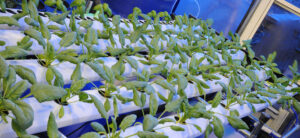
When it comes to learning how to grow hydroponic spinach, there is no shortage of information available online.
But how do you know what tips to trust? Fortunately, we’re here to set the record straight when it comes to growing spinach hydroponically.
Hydroponic gardening might seem intimidating, especially if you’re new to the practice.
However, with a bit of time and patience, you’ll find that it’s just as easy to learn how to grow hydroponic spinach as it is to grow spinach in any other fashion.
Keep reading to learn everything you need to know about growing spinach hydroponically - many of these tips can be applied to other leafy greens, too!
Can Spinach Be Grown Hydroponically?
Spinach not only can be grown hydroponically, but it’s also one of the easiest vegetables to grow in this fashion.
High in iron, folate, and other nutrients that are essential for good health, it grows quickly and in a compact fashion, making it perfect for hydroponic growing.
What Are The Benefits Of Growing Spinach Hydroponically?

There are many benefits associated with growing spinach hydroponically. For one, it means fewer pests, fewer diseases, less space required, and a more bountiful harvest.
Hydroponically grown spinach is also nutritious. Because it takes up very little space, you can grow large quantities of spinach (either all at once or in successive plantings) to maximize your yields.
A few other notable benefits include greater efficiency in terms of water used, and cleaner, better tasting plants.
This method really allows you to get the most out of your growing space, and produce bountiful harvests once you get the hang of it.
How Long Does It Take To Grow Spinach Hydroponically?
Spinach matures rapidly, regardless of whether it’s being grown in a hydroponic system or in the ground. However, most growers report accelerated growth rates when growing spinach hydroponically.
On average, you’ll find that your seedlings germinate in less than three weeks and that your plants are ready for harvest in just four to six weeks (often less if you don’t mind harvesting baby spinach leaves - these are often more tender!).
What Is The Best Variety Of Spinach To Grow Hydroponically?

You can grow any variety of spinach in a hydroponic environment. Some of the most popular include Noble Giant Spinach, Bloomsdale Spinach, New Zealand spinach, America Spinach, and Matador Viking Spinach.
All are incredibly flavorful, heirloom plants that vary in terms of how long they take to reach maturity.
Bloomsdale, for example, is ready for harvest in just a little over a month!
How To Grow Hydroponic Spinach - Step By Step Guide
If you’re ready to start growing spinach in your hydroponic set-up, consider this step-by-step guide to help you get going.
Start By Choosing The Best Hydroponic System For Spinach

When it comes to finding the right hydroponic system for growing spinach hydroponically, you have several different options at your disposal.
Ebb and flow, as well as nutrient film technique methods, tend to be the most effective for beginners growing spinach.
Hydroponic Ebb & Flow Systems
Ebb and flow is one of the most popular types of s systems for hydroponic growers. These systems are sometimes referred to as flood and drain and are ideal because they are so easy to operate.
Although there is still a learning curve involved, since an ebb and flow system has several moving parts, these systems are affordable and can help you maximize the amount of space you have available, especially if you use a rolling bench or stand to support your flood table.
At Hydrobuilder, we offer many sizes and types of ebb and flow systems. You’ll find all the systems and components you need to customize your own solution by shopping our ebb and flow category here.
Hydroponic NFT Systems
NFT, or nutrient film technique, is a convenient and versatile style of hydroponic growing that saves water and is perfect for growing leafy greens like spinach.
With this technique, you’ll be able to grow in a vertical fashion and you’ll limit the amount of salt that builds up in the roots of your plants.
It’s also easy to set up and perfect if you want to be able to keep an eye on the roots of your plants. Hydrobuilder has all the equipment you need to set up your NFT hydroponic growing area.
You’ll be able to save money by reducing the amount of water, nutrients, and growing media you need to use in this kind of system.
How To Start Hydroponic Spinach - Seeds vs Clones
There are several ways you can start hydroponic spinach plants, but the easiest way is to use rapid rooter plugs.
These will help you germinate seeds more quickly, generally just in a few days to weeks. Sow a few seeds per plug, which will improve the likelihood of a healthy seedling appearing.

You’ll need to keep these plugs at around 45-75 degrees Fahrenheit until seedlings appear. Once the seedlings appear above the starter cube, you can pinch heads off extra plants for each cube, allowing only the healthiest seedling to remain.
One more tip when it comes to starting spinach seeds? Cold stratify them first and put your spinach seeds in the refrigerator for up to three weeks before you plant. This often results in healthier plants.
If you want to have a constant supply of fresh spinach to harvest, sow seeds once every two weeks.
Don’t transition your starter seeds to your hydroponic system until their roots extend out of the germination medium. They’ll usually be around two or three inches tall at this point.
How Much Light Does Hydroponic Spinach Need?
Spinach requires about 10-14 hours of light per day. When it comes to growing spinach in a hydroponic environment, you have a few options.
You can use fluorescent lighting, which is inexpensive and puts out very little heat, something that’s helpful for cool-season plants like spinach.
You can also use LED lighting, which will be more energy efficient. The light does not need to be overly close to your plants.
In fact, too much light can cause your plants to become scorched and won’t be conducive to their growth.
Similarly, keep in mind that red and yellow light are not the best options for growing spinach, though they are ideal for other kinds of plants. Blue or white light is best to facilitate the production of chlorophyll.
As cool weather crops, spinach plants germinate and grow best when temperatures are between 45 and 65 degrees.
When the temperatures creep above 70 degrees, you’ll likely find that your spinach plants bolt - or produce flowers and start to go to seed.
Tips For Growing Spinach Hydroponically Indoors
Keep the pH of your hydroponic solution around 5.5 to 6.5. You will want to use a balanced fertilizer geared a bit more toward vegetative growth on your spinach plants.
After all, you want to encourage the plants to produce foliage, not to produce blossoms - you eat the leaves, right?
Use nutrients higher in nitrogen to attain this. Although this can vary depending on your setup, you will need to change out your nutrient solution around once every seven days or with your hydroponic spinach.
As your plants approach full maturity, you may want to reduce the frequency with which you fertilize your plants (or reduce the strength) so that the leaves do not become bitter.

Spinach plants are relatively easy to grow in that they don’t require any support. However, spacing is important.
You will want to space your plants to about five to six inches apart, perhaps even more if you plan on allowing the plants to grow to full size.
Fortunately, you don’t have to provide a very deep grow bed, as spinach is quite shallowly rooted.
Spinach is a fast-maturing crop that’s ready for harvest in just 30 to 45 days. You can harvest small leaves before then if you’d like to enjoy baby spinach or you can wait to cut the entire plant at once.
In most cases, it’s best to cut the outer leaves first, not removing more than a third of the plant at a time, and coming back again and again for additional leaves.
Final Thoughts On How To Grow Hydroponic Spinach
Now that you have all the knowledge you need to get started, it’s time to arm yourself with all of the equipment you need. The bad news is that hydroponic growing does require a relatively large amount of gear.
The good news is that you can find all of the supplies, from nutrients to growing media, by shopping our extensive hydroponics collection at Hydrobuilder.
We have everything you need for safe, effective, and convenient growing - all in a single one-stop-shop. Get started today!
































